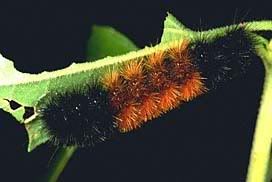is "woolly bear" what it's really called?That posed a very interesting question. I have never given the woolly bear a second thought and I don't rightly know. I grew up being told of the legend of the woolly bear. That legend was handed down to my parents from their parents and so on. I too have handed that legend down to the picklets. But with that question posed, why not put a little science and research into our homeschooling day?
The Old Farmer's Almanac says that the longer the middle brown band, the milder and shorter the coming winter; the shorter the brown band, the longer and more severe winter will be. This legend/old wives tale/superstition/folklore dates back to Colonial times.

In this picture Sweet took of the woolly bear she found, there is just one color, the middle brown band. It is large and indicates that the winter will be mild.

In this picture from E-Nature, you can clearly see the middle brown band and the two darker bands on each end. Finding this woolly bear would mean a semi-harsh winter.
The woolly bear is a furry caterpillar and is about 2 1/8"-2 1/4" long. It lives in most of North America. It is actually the larvae for a tiger moth. The Isabella tiger moth to be exact. The body is covered with fur (that isn't really furry but bristly) and is separated in three colors; with black on the ends and a reddish brown in the middle. It eats wild flowers and isn't usually a threat to crops, gardens and yard plants. It lives in meadows and wooded areas, and is seen crossing the road a lot this time of year. The woolly bear also has other names such as the black-ended bear. My guess each area/region probably has a different name for them.
According to the Ohio State Extension,
"The truth behind the woolly bear's band length actually has more to do with age
than with predicting the weather. As the caterpillar prepares to overwinter, the
caterpillar molts, becoming less black and more reddish-brown as it ages. Woolly
bears overwinter from September to May, and are commonly found along nature
trails and wooded edges and crossing sidewalks and roadways seeking
overwintering sites."
So, the woolly bear is just the caterpillar for a tiger moth. It, much like the weather prediction of the groundhog, is just legend. But, for those of us who were raised on that legend, we will continue to pass it down through the generations because it is tradition. And you don't monkey with tradition.
If you want more information there are tons of websites on the woolly bear. A few are:
Ohio State Extension
E-Nature
Old Farmers Almanac
Cold Spring School
Iowa State Extension
While looking for information, I found this site on how to keep a woolly bear over the winter. The picklets are now eager to find another woolly bear for "scientific purposes". Who am I to say no?
Thanks for asking the question Blossom, we absolutely love learning new things.

(c) 2008-2010 Wicked Pickles-Homefront Lines















No comments:
Post a Comment